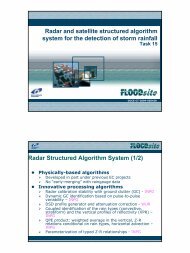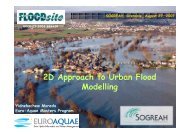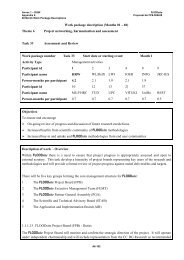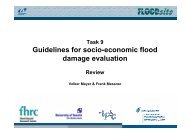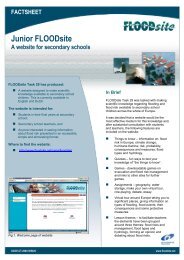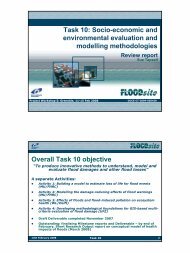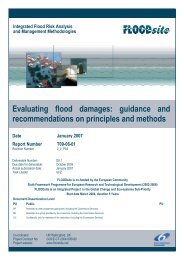Evacuation and traffic management (full report) - FLOODsite
Evacuation and traffic management (full report) - FLOODsite
Evacuation and traffic management (full report) - FLOODsite
You also want an ePaper? Increase the reach of your titles
YUMPU automatically turns print PDFs into web optimized ePapers that Google loves.
Task 17 <strong>Evacuation</strong> D17-1<br />
Contract No:GOCE-CT-2004-505420<br />
7.2 The choice of the Gard pilot area .................................................................... 132<br />
7.3 Description of the PICH inventory.................................................................. 132<br />
7.4 Hydrological data ............................................................................................ 134<br />
7.5 Geographical data ............................................................................................ 136<br />
7.6 Evaluation of the road vulnerability ................................................................ 137<br />
7.6.1 Introduction........................................................................................ 137<br />
7.6.2 Step 1: identification of the potentially flooded road sections........... 137<br />
7.6.3 Identification of road flooding vulnerability indicators ..................... 138<br />
7.6.4 Conclusions........................................................................................ 144<br />
7.6.5 Combination of flood vulnerability indicators ................................... 145<br />
7.6.6 Validation <strong>and</strong> conclusions ................................................................ 146<br />
7.7 Distributed rainfall-runoff simulation.............................................................. 147<br />
7.7.1 Specification of the rainfall - runoff model........................................ 147<br />
7.7.2 Model parameterisation...................................................................... 148<br />
7.7.3 Choice of Curve Numbers (CN)......................................................... 149<br />
7.7.4 Choice of river reach widths .............................................................. 149<br />
7.7.5 Calibration procedure......................................................................... 150<br />
7.7.6 Calibration results .............................................................................. 151<br />
7.7.7 Validation of the results ..................................................................... 154<br />
7.8 Conclusions ..................................................................................................... 155<br />
7.9 Development of a road inundation forecasting prototype ............................... 155<br />
7.9.1 Objectives <strong>and</strong> evaluation criterions .................................................. 155<br />
7.9.2 Definition of a submersion risk index ................................................ 156<br />
7.10 Evaluation of the proposed approach .............................................................. 157<br />
7.10.1 Detection of the hot spots................................................................... 157<br />
7.10.2 Time sequence of submersion warnings ............................................ 160<br />
7.11 Use of emergency routing techniques developed by the Orchestra project piloted in the<br />
Gard Region..................................................................................................... 162<br />
7.11.1 Introduction........................................................................................ 162<br />
7.12 Background to the internet based routing services developed under Orchestra165<br />
7.13 Application of the web based routing services to the Gard Region................. 166<br />
7.14 End user consultation....................................................................................... 166<br />
7.14.1 Background ........................................................................................ 166<br />
7.14.2 User feedback..................................................................................... 167<br />
7.15 Conclusions ..................................................................................................... 168<br />
8. Conclusions <strong>and</strong> recommendations.............................................................................. 169<br />
8.1 Conclusions ..................................................................................................... 169<br />
8.1.1 Introduction........................................................................................ 169<br />
8.1.2 User requirements for evacuation planning........................................ 169<br />
8.1.3 <strong>Evacuation</strong> modelling for flood event <strong>management</strong>........................... 169<br />
8.1.4 Application of evacuation models in the Thames Estuary ................. 170<br />
8.1.5 Application of evacuation models in the Schelde Estuary ................. 170<br />
8.1.6 Development of a prototype flash-flood warning system for roads in the Gard<br />
Region ................................................................................................ 172<br />
8.2 Recommendations ........................................................................................... 172<br />
9. References .................................................................................................................... 173<br />
Tables<br />
Table 2.1 Management activities in the UK 12<br />
Table 2.2 Response activities in the UK 13<br />
Table 5.1 Selected LSM objects 66<br />
Table 5.2 Range of scenarios modelled for Thamesmead showing the code used to denote each<br />
model run 70<br />
T17_07_02_<strong>Evacuation</strong>_<strong>and</strong>_<strong>traffic</strong>_<strong>management</strong>_D17_1_V4_4_P01.doc 19 03 2008<br />
viii




